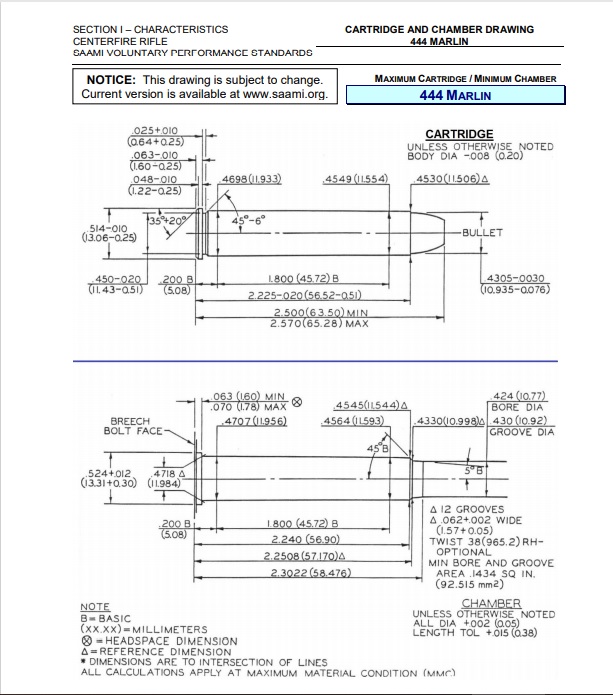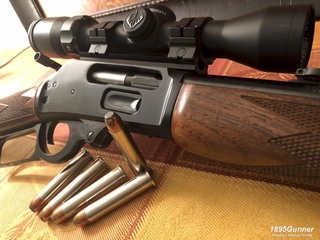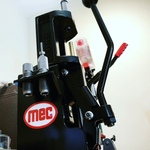 |
KNOWLEDGE CENTER1 8 9 5 G U N N E R.C O M
|
 |
KNOWLEDGE CENTER1 8 9 5 G U N N E R.C O M
|
Home > Knowledge Center > 444 Marlin444 MarlinHistoryIn the early 1960’s, flat shooting high velocity cartridges had achieved immense success and there were no lever action big bore rifles being manufactured at this time. The 45-70 had phased out of popularity leaving a big gap. This is where the Marlin Firearms Company stepped up big time to fill that gap.In a somewhat radical move Marlin chose the .44 Magnum as the basis for a big bore cartridge and rifle combination. In collaboration with Remington the .44 Magnum case was lengthened by a full inch, resulting in a huge boost in case capacity. The case was also widened at the head by 0.14”, featuring a steady taper, rather than utilizing the straight form of the parent case. This new cartridge was named the .444 Marlin and was introduced along with the big bore Marlin model .444 rifle in 1964. The original rifle featured a 24” 1:38 twist microgoove (12 groove) barrel. In fact my first centerfire rifle purchased was a Marlin .444 built in 1981. Still to this day one of my favorite cartridges! I bought mine on the last day of the Iranian hostage crises that lasted 444 days. I saw it as an omen. I was headed to a whitetail hunt and wanted a .45-70 however after the news of the release of hostages I jumped on the chance for a .444. Remington initially produced one load for the .444, featuring a 240 grain soft point bullet at 2,350fps. Although this load worked well for the general hunter targeting lighter bodied game, this single offering did not fully exploit the potential of the .444. This shortcoming was partially rectified in 1967 when Hornady released a hard hitting 265 grain flat point. Sad to say that as of this writing, Hornady has discontinued the 265 grain Interlock bullet leaving many hand loaders without a suitable replacement. In 1972 Marlin Firearms Company reintroduced the new model 1895 chambered in .45-70, after which the .444 gradually fell out of favor. Fortunately, Marlin continued to produce .444 rifles, off and on adopting a 22” barrel with 1:20 twist Ballard rifling in 1999. My favorite Marlin .444 is the Model 444P which is an 18-1/2” factory ported “outfitter”, identical in every way to Marlin’s Guide Guns. This model was made available from 1999 – 2002. Today the .444 has a smaller however steadfast following among lever action big bore enthusiasts. The .444 is a very unique cartridge and never fails to generate discussion. As of this time of writing, the .444 is likely to be produced again by Ruger who has purchased the Marlin Firearms Company from Remington Firearms. I highly recommend a Marlin .444 rifle simply for the pure joy it brings. Go on… you know you want one!
PerformanceOne of the finer virtues of the .444 is that it produces fairly mild recoil. Firing a 240 grain bullet at around 2350 to 2450fps. The recoil level of the triple four is in no way the same as that produced by a hot .45-70 or a bolt action African game cartridge. Provided technique is sound, any able bodied adult can enjoy using the longer .44.I’ve found the .444 cartridge to be a very good medium sized game choice for hunting deer, wild boar and even black bear. Bullet choices must be considered for each game type however a favorite of mine was the Hornady 265 grain Interlock. The .444 is a very formidable cartridge when used within its capabilities. Remington continue to produce their original load for the .444, but this load is now only available in limited production runs (possibly defunct following Remington’s 2020 closure). The Remington load consists of a 240 grain projectile loaded to a muzzle velocity of 2,350fps. In order to aid penetration this projectile features a soft point rather than the typical wide hollow point widely utilized in the .44 Magnum. The result is a projectile which produces very fast expansion (also thanks to the generously exposed lead) and what can best be described as fair penetration. Hornady currently produces one load for the .444 Marlin, the Leverevolution 265 grain FTX loaded to 2,325fps. As mentioned previously they discontinued the Superformance 265 grain flat point at 2,400fps. The FTX is a bit of a strange adaptation for lever action, tubular fed magazines. The FTX is designed with a pointed ogive and rubber tip in order to enhance external ballistics but without causing detonation when stacked in tube loading rifles. The ogive of the FTX is heavily notched in order to promote rapid expansion while the thick SST style jacket is designed to aid penetration. The result is a load that dumps its energy in the most violent and rapid manner. The FTX is not a deep penetrating load. I hand load this bullet for my .444’s and the heavier 325 grain FTX for my .45-70’s with great success
Hand loadingBrass for the .444 can be sourced from spent factory ammunition or purchased new from Starline Brass and Hornady. Hand loaders must take note however, that brass sourced from once fired Hornady Leverevolution ammunition is short at 2.065”, compared to 2.250” for regular brass (including Hornady flat point ammunition). The short Leverevolution brass was designed to accommodate the long rubber tipped bullet. By the same token, those who wish to use either the 225 or 265 grain FTX projectiles will need to utilize the shorter 2.065 OAL.The Marlin is a strong rifle but the .444 is only rated to 42,000psi so some care must be taken. Having said this, the current reloading manuals as well as most published articles make absolutely no mention of high bulk density fast burning powders suitable for experimentation with lighter weight projectiles. Instead, all that one finds are references to the 4198 burn rate which is bulky, handicapping the .444 (again light bullets) by at least 200fps. Hornady published a powder chart for hand loading the .444 when they introduced the 265 grain FTX bullet. It listed both IMR & H4198 along with VIHT N-120 and AA1680. The triple four does not need a long barrel in order to achieve full speeds due to the very fast burning powders. 20” is about optimal with a velocity loss of around 25fps per inch of barrel docked below this point. From the 22” barrel of the current Marlin rifles, top velocities for the .444 include 2,800fps with the 180 grain XTP, 2,650fps with 200 grain bullets, 2,600fps with 210 grain projectiles, 2,550fps with 225 grain projectiles, 2,450fps with 240 grain bullets, 2,300fps with 265-270 grain bullets, 2,200fps with the 270 grain Speer and 280 grain Swift and 2,100fps using 300 grain bullets. As for heavy cast bullets, a 335 grain projectile can be driven at around 1,950fps, a 350 grain at around 1,900fps and the 405 grain at around 1,800fps. Current reloading options from Hornady include the 180 grain XTP, the 200 grain XTP, the 225 grain FTX, the 265 grain FTX and the 300 grain XTP. Sierra projectiles include the 180 grain JHC, the 210 grain JHC, the 240 grain JHC, the 250 grain FPJ and the 300 grain JSP. Speer offers a range of projectiles which can be put to great use in the.444. The current offerings include the 200 grain Gold Dot Personal Protection (deep hollow point), the 210 grain Gold Dot Personal Protection (shallow dish shaped hollow point), the 240 grain Gold Dot Deep Curl Hunting hollow point (shallow dish shaped hollow point), the 240 grain Deep Curl Hunting soft point and the 270 grain Deep Curl Hunting soft point. Nosler currently produce four very basic cup and core projectiles including a 200 grain JHP, a 240 grain JHP, a 240 grain JSP and a 300 grain JHP. From these less than exciting options, the 300 grain JHP has some merit for use on larger bodied animals such as Red and Mule Deer. Swift options include the 240, 280 and 300 grain A-Frame hollow point projectiles. Each can be used with great success in the .444. Barnes currently produce 200 and 225 grain XPB projectiles. Both are designed for the .44 Magnum yet both tend to display better performance in the .444. These projectiles are as long as conventional 300 grain bullets. In the .44 Magnum the Barnes take up too much powder space, the low speeds combined with slow twist rates (Marlin rifles) producing terrible accuracy. Terminal performance can also be found wanting at lower impact velocities. The large case volume of the .444 can help to ease some of these issues. At this time of writing there are several companies offering hard cast projectiles. Among these, Beartooth stand out with their 335, 350 and 405 grain options. Each are true Keith style designs boasting huge meplats, minimal expansion and deep penetration
Final thoughtsThe .444 Marlin is almost the perfect cartridge for a quick shooting lever action at reasonable distances. I find the hunting in the Eastern United States with heavy timber and generally shorter distances, the cartridge performs extremely well on medium sized game such as the whitetail deer. I prefer the shorter barreled Outfitter configuration for pushing through tight brush however I’m just as comfortable with a longer barreled version.The hand loader has many options for loading over available factory ammunition. Experience and planning should go into load development for the game you plan to hunt over your presumed target distances.

 |
| |
|
|
 |
 |
 |
 |
 |